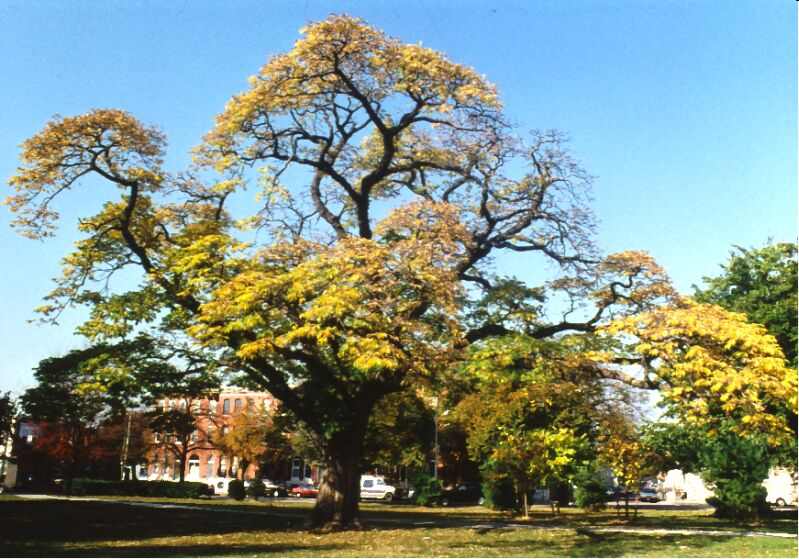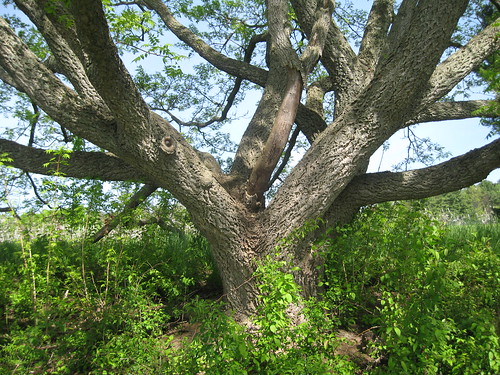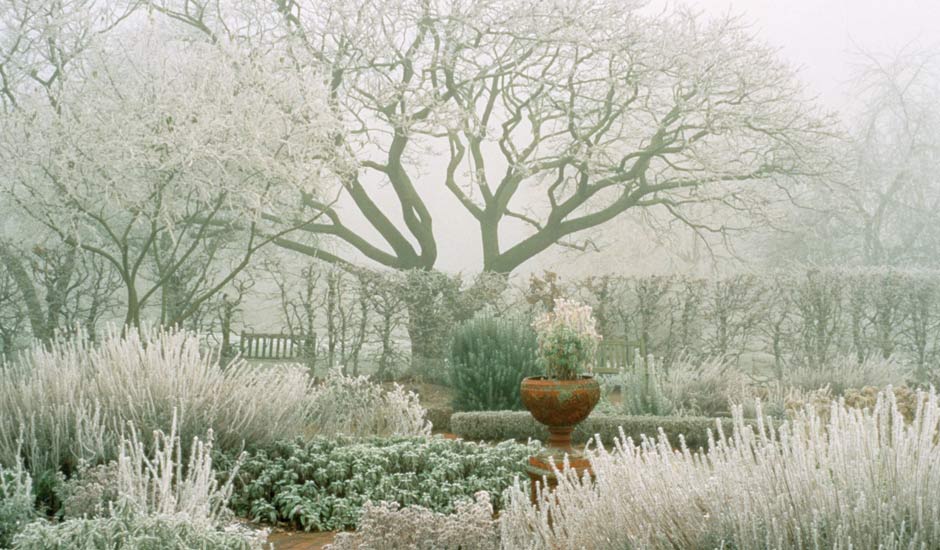Amur Cork Tree Biography
Amur corktree is a deciduous tree named for its thick corky bark (from Greek: phellos for cork and dendron for tree). Mature trees have shelf-like branching and grow from 35-50 ft in height with a spread nearly as wide. Corktree bark is a light golden brown on younger trees and gray-brown, ridged, and furrowed on mature trees. Both young and old trees have bark that is slightly spongy or corky to the touch and a distinctive bright neon yellow layer of inner bark that can be revealed with a quick scrape of a pocket-knife. The leaves are opposite, pinnately compound and composed of 5-13 entire leaflets that are dark green, turning bright yellow in the fall. When crushed, the leaves have a distinctive citrusy smell sometimes likened to a disinfectant or skunk odor. Male and female plants are separate (dioecious) and each bears hanging panicles of yellowish-green flowers from May through June. From mid-June to mid-July, female trees produce abundant clusters of fruits (technically drupes) which are ¼ to ½ in. diameter. The fruits bright are green, turning black in late summer to fall, and may remain on the tree until early winter. Male trees do not produce fruit. The wood of the tree is strong and rot resistant and is prized by some woodworkers.
Amur corktree is invasive in parks and natural areas in New York City, New York and Philadelphia, Pennsylvania, where it has escaped from plantings. Within fifty years of its planting as an ornamental, it has become a dominant tree in New York City parks. The establishment and spread of corktree at three Audubon wildlife sanctuaries in eastern Massachusetts has been documented. It does especially well in forests and wooded areas that have been exposed to human disturbance, where it forms dense stands and crowds out native species. Corktree changes the light regime of forest understory with shelf-like branching that shades out seedlings of competing species. The high volume of seed produced and relative lack of seed predators gives it an additional competitive advantage over native species.
Amur corktree is a deciduous tree named for its thick corky bark (from Greek: phellos for cork and dendron for tree). Mature trees have shelf-like branching and grow from 35-50 ft in height with a spread nearly as wide. Corktree bark is a light golden brown on younger trees and gray-brown, ridged, and furrowed on mature trees. Both young and old trees have bark that is slightly spongy or corky to the touch and a distinctive bright neon yellow layer of inner bark that can be revealed with a quick scrape of a pocket-knife. The leaves are opposite, pinnately compound and composed of 5-13 entire leaflets that are dark green, turning bright yellow in the fall. When crushed, the leaves have a distinctive citrusy smell sometimes likened to a disinfectant or skunk odor. Male and female plants are separate (dioecious) and each bears hanging panicles of yellowish-green flowers from May through June. From mid-June to mid-July, female trees produce abundant clusters of fruits (technically drupes) which are ¼ to ½ in. diameter. The fruits bright are green, turning black in late summer to fall, and may remain on the tree until early winter. Male trees do not produce fruit. The wood of the tree is strong and rot resistant and is prized by some woodworkers.
Amur corktree is invasive in parks and natural areas in New York City, New York and Philadelphia, Pennsylvania, where it has escaped from plantings. Within fifty years of its planting as an ornamental, it has become a dominant tree in New York City parks. The establishment and spread of corktree at three Audubon wildlife sanctuaries in eastern Massachusetts has been documented. It does especially well in forests and wooded areas that have been exposed to human disturbance, where it forms dense stands and crowds out native species. Corktree changes the light regime of forest understory with shelf-like branching that shades out seedlings of competing species. The high volume of seed produced and relative lack of seed predators gives it an additional competitive advantage over native species.
Amur Cork Tree
Amur Cork Tree
Amur Cork Tree
Amur Cork Tree
Amur Cork Tree
Amur Cork Tree
Amur Cork Tree
Amur Cork Tree
A "Living Room" In A Garden
Amur Maple 72610







No comments:
Post a Comment